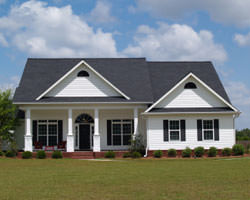
The EPA updated the guidelines for Energy Star-certified homes. The guidelines, which will take effect in 2012, include new guidelines for thermal home-enclosure systems.
We’ve all seen that blue-scribbled star beacon of sustainability. Shopping around for a new air conditioner or refrigerator is always met with an “Oh, think of the electric bill savings!” when you come across an Energy Star product. You often leave the store feeling you can’t afford not to upgrade.
Now that blue-star label of eco-conscious, cost-conscious splendor is not only available for your microwave but for your front door, too.
You might have already heard of EPA-certified Energy Star homes, but now the organization is putting new regulations in place to reach even greater heights of energy efficiency (20 percent greater) that will have your checking account and planet Earth saying, “It’s about time!”
The new guidelines are broken down into versions. The current guideline version developed in 2006 is referred to as 2.0, meaning if your house is currently certified, you meet all the standards outlined by that version. However, the EPA has set new goals for their version 3.0 Energy Star-certified homes to take effect in 2012.
The new guidelines for the 3.0 Energy Star certification have taken into consideration the criticisms of homeowners and contractors responsible for the more than 1 million homes in the U.S. that meet the EPA’s 2.0 regulations.
“The concept is the same,” says Joseph Nespoli, chief of Energy Star-certified construction for state-based contracting company Campo Brothers. “Now, the plan is to tighten up the house even more.”
EPA-rated modifications are broken down within these outlined categories:
- a complete thermal home-enclosure system (super-efficient insulation, windows and doors)
- quality-installed, complete heating and cooling systems (AC oasis, cozy dens and hot showers)
- a water-management system (moisture control for temperature stability and health risks that come with having a climate-controlled home)
- efficient lighting and appliances (the aforementioned Energy Star-labeled refrigerator and those compact florescent/curlicue light bulbs).
Lastly, homeowners or contractors wanting to build according to the EPA’s new guidelines will need a third-party verifier to sign off on all improvements.
Reading about the new requirements of the 3.0 Energy Star home is not for the amateur recycling, bicycle riding, composting, energy-efficient-light-bulb-using environmentalist. For those well-versed in construction jargon, this project might be a cinch. Revisions like, “whole-building mechanical ventilation design requirements have been updated to prohibit the use of an intake duct on the return side of the HVAC system,” might sound perfectly natural to some, but for the rest of us, there is an extensive list of more than 8,500 Energy Star/EPA-certified contractors, easily searchable by location and expertise on the Energy Star website.
Along with the warm, fuzzy feeling of doing something good for the world, a newly improved Energy Star home will bring homeowners an estimated energy savings of $200 to $400 per month according to the EPA. Also, through December 2016, the U.S. government is offering tax breaks of up to 30 percent of the total cost of renovations and upgrades.
In order to reap savings on your roof, water heater, insulation, air conditioning, windows, and doors, apply for your tax break before the end of 2010.
















